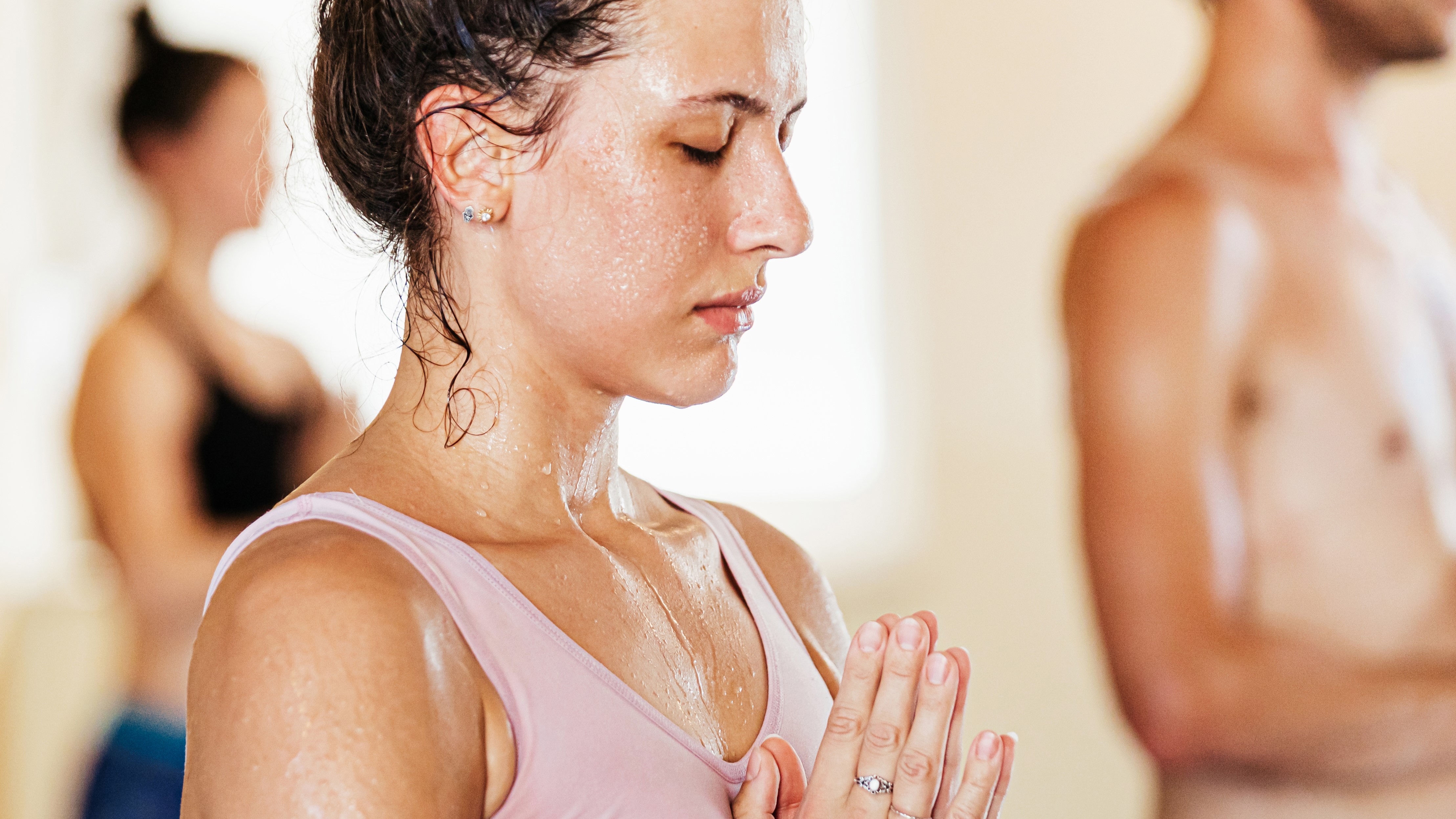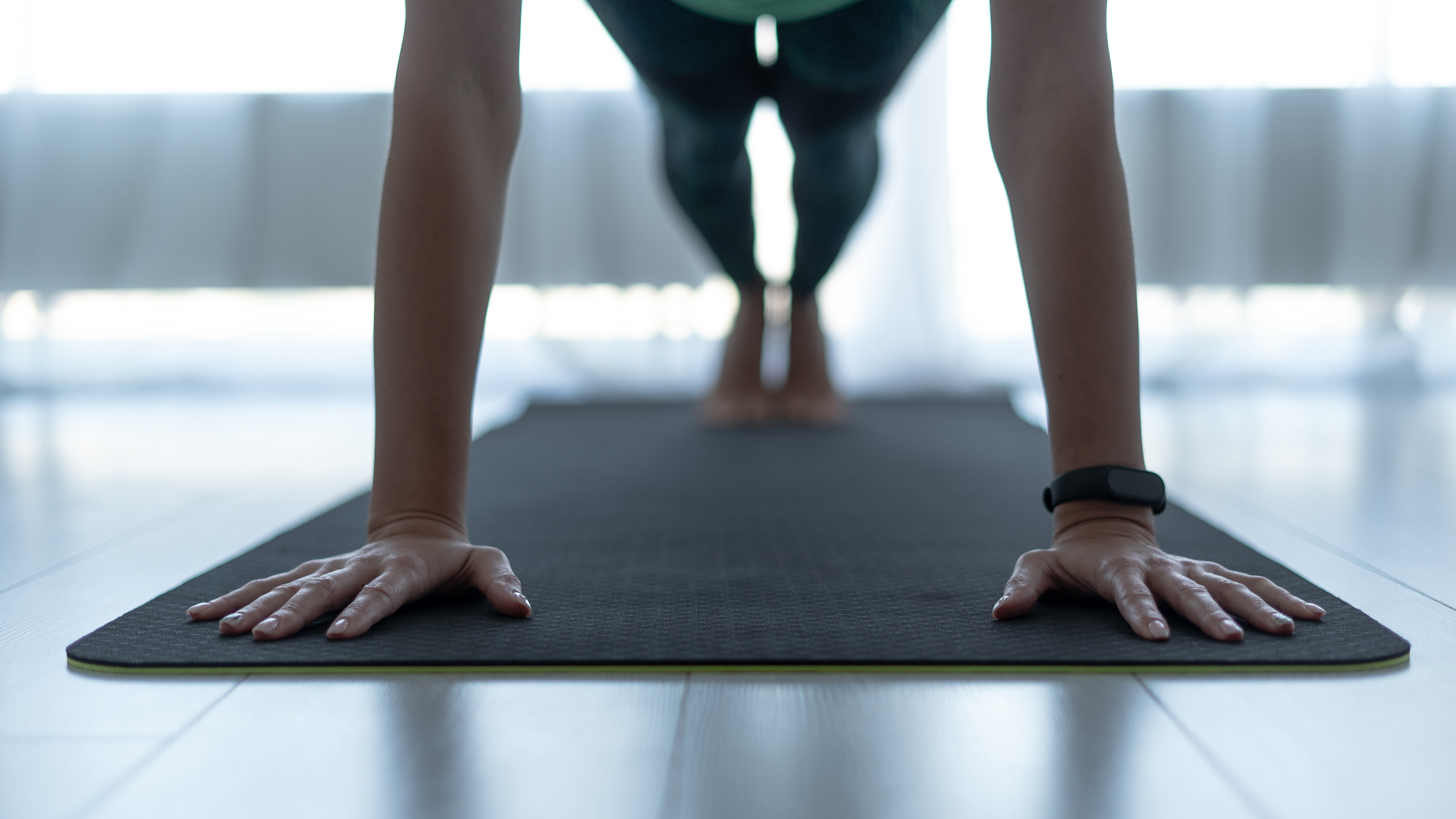Is hot yoga good for athletes?
We look at the research on hot yoga, and how it may benefit athletes

It’s Monday night and I’m holding a plank in yoga class. A single bead of sweat rolls down my arm thanks to the temperature in the room which is heated to a welcoming 89°F. This winter, which has seemed interminably long and unusually cold here in Scotland, I’ve quietly fallen back in love with hot yoga. Once a week or so, usually the day after a long run, I come here to stretch it out and warm my bones.
Over the years, I’ve formed a love/hate relationship with hot yoga, having discovered it when I lived in New York where it was all the rage in the early noughties. When I moved to Colorado and learned that hot yoga there seemed to be synonymous with super fast-paced flows, I found it didn’t provide the recovery I needed when I spent so much time on the Rocky Mountain trails and my single visit to a Bikram Studio in San Francisco a decade ago was plenty for me to rule that out forever. But these days, so long as it’s not too hot or fast, I’m finding once again that it provides a nice balance to the time I spend in my hiking boots, trail running shoes and climbing shoes.
In my 15 years of teaching yoga, I’ve seen people flock to hot yoga in droves, packing out studios to the point where the unsuspecting yogi might get kicked in the face or worse, sweated upon by a stranger. Among them, many athletes in particular seem drawn to this particular style of of yoga, perhaps because they like their exercise to feel hard, or maybe because most of us feel like we can find more flexibility in the heat – but is there any real benefit to practicing yoga in a heated room? And is hot yoga good for athletes?

What is hot yoga?
Though the terms “hot yoga” and “Bikram yoga” are often used interchangeably, they’re not necessarily the same the same thing. Hot yoga can be any style of yoga (usually Vinyasa or Power Yoga) taught in a warm room that’s typically upwards of 85°F (29°C).
Bikram Yoga is a series of 26 postures taught in a room heated to 105°F (40°C) room that was trademarked by the highly questionable Bikram Choudhury and has a cult-like following.
For the purposes of this article, I’m writing about any yoga done in a hot room. If you want to know more about Bikram Yoga specifically, I suggest you start with the 2019 Netflix documentary Bikram: Yogi, Guru, Predator.
What are the benefits of hot yoga?
According to the most recent Yoga in America study, conducted in 2016 by Yoga Alliance, 36 million Americans practice some type of yoga, and based on the proliferation of hot studios across the country, it’s safe to say a good chunk of these like the thermostat cranked up while they flow.
All the latest inspiration, tips and guides to help you plan your next Advnture!
Of those people, nearly 80 percent engage in other forms of exercise like running and cycling, while some of the top reasons people cite for practicing yoga are that they believe it increases flexibility and strength and enhances athletic performance. But what does the science say?

For starters, it may have mental health benefits. A 2023 randomized controlled trial by researchers at Harvard Medical School concluded that symptoms of depression eased by 50 percent or more for about 60 percent of those practicing hot yoga twice a week for eight weeks. As a stand-alone mental health intervention then, hot yoga seems to have potential – which may explain why I’ve been drawn to it during Scotland’s long, dark winter – but the trial didn’t look at whether hot yoga was more effective than room temperature yoga, so it’s hard to say if the heat was the key here.
A small 2020 study published in the International Journal of Exercise Science looked the effects of doing the Bikram sequence in a heated room versus doing it at room temperature. Researchers examined changes in range of motion, oxygen consumption, caloric expenditure and biomarkers of acute stress and inflammation. Though hot yoga can definitely feel much harder, their study concluded that a heated environment does not significantly increase the aerobic energy cost. It may, however, acutely increase the content of fat used as an energy source as well as improving hip flexion and abduction.
However, if you’re familiar with the Bikram sequence, you’ll know that compared to practices like Vinyasa, it’s not particularly dynamic, so it’s possible that comparing it to room temperature Vinyasa would produce different results, though I’m just speculating here based on my professional experience.
In another study on the Bikram method, carried out in 2013 and published in the Journal of Strength and Conditioning Research, a small group of young and relatively sedentary people were assigned to a hot yoga regimen and assessed for changes to isometric deadlift strength, handgrip strength, lower back, hamstring and shoulder flexibility, resting heart rate, blood pressure, VO2 max and lean and fat mass. Compared to the control group, the test subjects displayed increased deadlift strength, substantially increased lower back and hamstring flexibility, increased shoulder flexibility and modestly decreased body fat compared with the control group.
This seems like a win for hot yoga, but the study isn’t clear about what the control group did over the eight weeks. If they didn’t undergo any training regime, which we can reasonably assume, then it wouldn’t be surprising that the group that started exercising three times a week would see some physical gains in comparison.

If you’ve taken a hot yoga class, you might be surprised to learn that researchers haven’t seen it produce any significant aerobic gains. After all, you’ll be familiar with that feeling of your heart pounding 30 minutes into class because it’s so hot you feel like you’re going to pass out, but a 2016 study sponsored by the American Council on Exercise had subjects swallow a Core Body Sensor to compare their core boy temperature and heart rate in a 92°F practice versus room temperature. Though they observed the subjects sweating profusely, they didn’t find in real difference in core temperature or heart rate and suggested that it’s largely the Perceived Rate of Exertion that is higher among those of us practicing hot yoga.
This one pulled me up short as I’ve always felt that hot yoga is more strenuous, and looking back at the yoga sessions I've recorded on my GPS watch, I can see a clear increase in my heart rate in a hot class versus my home practice, to the tune of about 34 extra heart beats per minute. Then again, I have to concede that I probably don’t push myself as hard as a teacher does.
There’s one other interesting piece of research on the potential benefits of hot yoga that I want to mention. In the lead up to the 2016 Olympics, a team of researchers from the University of British Columbia and Simon Fraser University performed a six-day study to try to determine whether hot yoga could be an effective form of heat training. As I’ve previously reported, heat training involves training at slightly higher temperatures than usual to get your body to produce more plasma, lower the temperature at which you start to sweat and produce more sodium, which gives you a competitive advantage on race day.
Interestingly, the study found that after hot yoga (not Bikram), the subjects didn’t exhibit increased plasma as expected – they were, unsurprisingly, dehydrated, meaning their plasma levels had decreased. However, when the time came to simulate competition, a massive increase in plasma volume was noted, which researchers posit would produce performance improvements. They concluded that hot yoga could indeed be an alternative heat training technique that puts minimal stress on the subject and can help preserve maximal cardiovascular performance during rest weeks.

Is hot yoga good for athletes?
The evidence here does suggest that hot yoga may hold some value for some athletes, but of course it all depends on your sport, and the yoga. If you’re a rock climber, increased shoulder flexibility and improved hip mobility could be really helpful, and that’s no doubt why so many of my yoga students have been competitive climbers over the years. But for a runner, those benefits aren’t likely to do you much good and if you’re a sprinter, you want to avoid stretching out those fast-twitch muscle fibers in your glutes as much as you can to improve your power.
Any athlete can benefit from the mental health implications of hot yoga obviously, though there’s no evidence to suggest you wouldn’t get the same benefits from room temperature yoga. Hot yoga will dehydrate you, so it’s probably not the best thing to do the day before you run a marathon, but it’s also not likely to dehydrate you any more than a long run, so it just needs to be timed correctly to give you time to hydrate before competition.
For me, the research on heat training is the most compelling argument for hot yoga, particularly for endurance athletes, and ultimately it seems like it could be an effective tool to preserve your cardiovascular performance without placing added strain on your soft tissues or cardiovascular system.
Ultimately, if you’re curious about hot yoga as an athlete, your best option is to try it – just not immediately before a big performance. If you enjoy it, and you feel it benefits you, then it’s probably good for you.
Julia Clarke is a staff writer for Advnture.com and the author of the book Restorative Yoga for Beginners. She loves to explore mountains on foot, bike, skis and belay and then recover on the the yoga mat. Julia graduated with a degree in journalism in 2004 and spent eight years working as a radio presenter in Kansas City, Vermont, Boston and New York City before discovering the joys of the Rocky Mountains. She then detoured west to Colorado and enjoyed 11 years teaching yoga in Vail before returning to her hometown of Glasgow, Scotland in 2020 to focus on family and writing.

